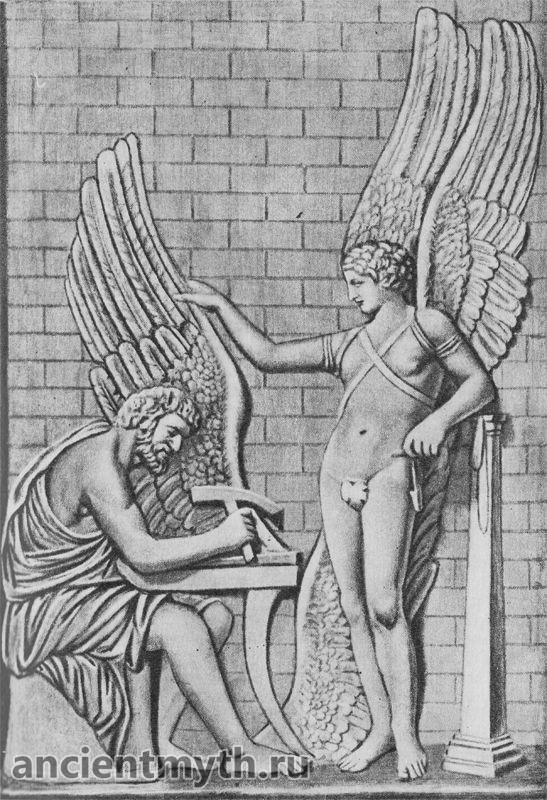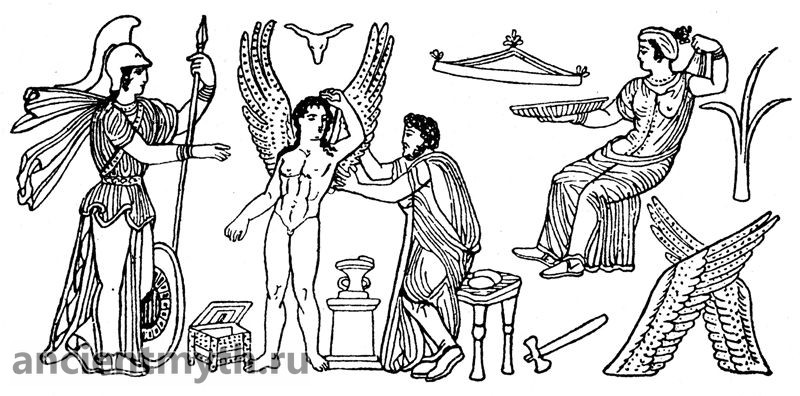Daedalus and Icarus
The greatest painter, sculptor and architect of Athens was Dedalus, a descendant of Erekhteyo. It was said about him that he carved such marvelous statues from snow-white marble that they seemed alive; the statues of Daedalus seemed to be watching and moving. Many tools were invented by Daedalus for his work; he invented the ax and the drill. The glory of Daedalus went far.

(Bas-relief, 2nd century BC)
This great artist had a nephew Tal, the son of his sister Perdiki. Tal was a student of his uncle. Already in his early youth, he amazed everyone with his talent and ingenuity. It could be foreseen that Tal would far surpass his teacher. Daedalus was jealous of his nephew and decided to kill him. Once Daedalus stood with his nephew on the high Athenian Acropolis at the very edge of the cliff. No one was visible around. Seeing that they were alone, Daedalus pushed his nephew off the cliff. The artist was sure that his crime would go unpunished. Falling from a cliff, Tal crashed to death. Daedalus hastily descended from the Acropolis, raised the body of Tal and already wanted to secretly bury it in the ground, but the Athenians caught Daedalus when he was digging a grave. The crime of Daedalus was revealed. The Areopagus sentenced him to death.
Fleeing from death, Daedalus fled to Crete to the mighty king Minos, the son of Zeus a> and Europe. Minos willingly took under his protection the great artist of Greece. Many marvelous works of art were made by Daedalus for the king of Crete. He also built for him the famous palace of the Labyrinth, with such intricate passages that once entering it, it was impossible to find a way out. In this palace Minos imprisoned the son of his wife Pasiphae, the terrible Minotaur, a monster with a body a man and a bull's head.
Dedalus lived with Minos for many years. The king from Crete did not want to let him go; only he wanted to use the art of the great artist. Like a prisoner, held Minos Daedalus in Crete. Daedalus thought for a long time how to escape him, and finally found a way to free himself from Cretan bondage.

(Design on a vase)
- If I cannot, - exclaimed Daedalus, - be saved from the power of Minos neither by land nor by sea, then the sky is open for flight! Here is my way! Minos owns everything, only he does not own the air!
Dedalus set to work. He collected feathers, fastened them with linen thread and wax, and began to make four large wings from them. While Daedalus was working, his son Icarus played near his father: either he caught the fluff that flew up from the breath of the breeze, or he crumpled the wax in his hands. The boy frolicked nonchalantly, he was amused by his father's work. Finally, Daedalus finished his work; the wings were ready. Daedalus tied the wings behind his back, put his hands into the loops attached to the wings, waved them and smoothly rose into the air. Icarus looked in amazement at his father, who soared in the air like a huge bird. Daedalus descended to earth and said to his son:
- Listen, Icarus, now we will fly away from Crete. Be careful while flying. Do not go too low to the sea, so that the salt spray of the waves does not wet your wings. Do not rise even close to the sun: the heat can melt the wax, and feathers will scatter. Follow me, keep up with me.
The father and son put wings on their hands and rushed lightly. Those who saw them flying high above the earth thought that these were two gods rushing through the azure sky. Daedalus often turned around to see how his son was flying. They have already passed the islands of Delos, Paros and fly farther and farther.
Fast flight amuses Icarus, he flaps his wings more and more boldly. Icarus forgot his father's instructions; it doesn't follow him anymore. Strongly flapping his wings, he flew high under the very sky, closer to the radiant sun. The scorching rays melted the wax that fastened the feathers of the wings, the feathers fell out and scattered far through the air, driven by the wind. Icarus waved his hands, but there are no more wings on them. Headlong he fell from a terrible height into the sea and died in its waves.
Dedalus turned around, looking around. No Icarus. Loudly he began to call his son:
Icarus! Icarus! Where are you? Reply!
No response. Daedalus saw on the sea waves the feathers from the wings of Icarus and understood what had happened. How hatedDaedalus dreamed of his art, how he hated the day when he planned to escape from Crete by air!
And the body of Icarus for a long time rushed along the waves of the sea, which became known by the name of the deceased Ikarian. Finally, his waves washed up on the shore of the island; Hercules found him there and buried him.
Dedalus continued his flight and finally arrived in Sicily. There he settled with the king Kokal. Minos found out where the artist had hidden, went with a large army to Sicily and demanded that Kokal give him Daedalus.
The daughters of Kokal did not want to lose such an artist as Daedalus. They came up with a trick. They persuaded the father to agree to the demands of Minos and accept him as a guest in the palace. When Minos was taking a bath, the daughters of Kokal poured a cauldron of boiling water over his head; Minos died in terrible agony. Daedalus lived for a long time in Sicily. He spent the last years of his life at home, in Athens; there he became the ancestor of the Daedalides, a glorious family of Athenian artists.